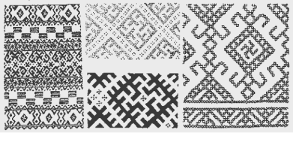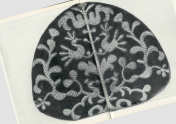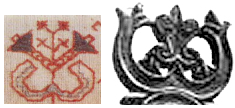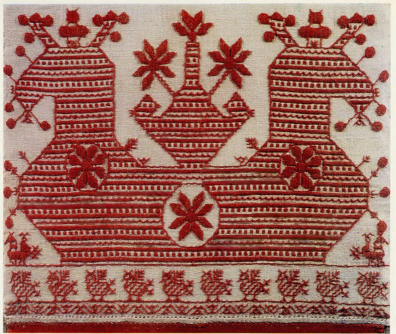You are currently browsing the category archive for the ‘Russian and Sanskrit’ category.
I have decided to upload a draft of my RUSSIAN – SANSKRIT DICTIONARY OF COMMON AND COGNATE WORDS which is the result of some eight years of work. This dictionary has been conceived as a practical reference book with the objective of providing factual material for researchers in the field of the Indo-European linguistics or anyone interested in etymology, semantics and the origin of the Indo-European, particularly, Slavonic languages. Compiling a dictionary is time-consuming and it is a mammoth task to do for a single person. The first draft published here is only a rough approximation. It contains only 488 entries, which is about a quarter of the planned volume, and still lacks some essential parts in the Introduction section. The entries have not yet been properly proof-read and I am constantly updating the comments.
You may access the text at my page on Academia.edu

Although this work is titled ‘Dictionary’ it is neither a traditional Russian-Sanskrit dictionary nor a formal etymological dictionary, but rather a catalogue of various cognate, common or otherwise connected Russian and Sanskrit words, arranged is a systematic way with cross-references, explanatory notes, links to other Slavonic and Indo-European languages, indexes and other features aimed at making it a valuable and convenient reference book. The specific task called for employing both Cyrillic and Devanagarī scripts throughout the book because transliteration, however elaborate, cannot fully replace the native writing system. Since it is unlikely that every reader would be proficient in both scripts, each word is accompanied by a conventional transliteration.
In writing this book I endeavoured to go through all major works dedicated to this issue starting from the discovery of Sanskrit and its relation to the European languages in general, and particularly to Slavonic, covering the period from the 17th century up to the modern days. Each proposed cognate word has been carefully evaluated, checked through various dictionaries and, sometimes, re-linked or rejected. This method provided some eight hundred pairs that made the back-bone of the dictionary. The rest of the cognate pairs (about another thousand two hundred) are the result of many years of scrupulous research.
Many cognate pairs are obvious, some need more or less detailed explanations and might be difficult to apprehend without some basic knowledge of the principal linguistic concepts and terms. This is why the dictionary is prefaced by an Introduction containing some essential information about the Russian and Sanskrit languages and their phonetic and grammatical features with particular attention to the principal rules of sound correlation. This section is now in work and it is not included in this draft.
I would be grateful for any constructive criticism or comments. If you would like to support this project there are several ways of helping me with the work:
- report any spelling or other mistakes that you have noticed
- suggest any other cognate pairs
- check the various cognates I mention in Slavonic and other languages if they happen to be in your native language
Going through some old Russian journals I came across an article by Svetlana Žarnikova (Zharnikova) “Kto my v ėtoj Evrope [Who are we in this Europe]”. Nauka i žizn’, Issue No. 5, 1997.
Žarnikova is known as one of the Russian protagonists of the controversial “Hyperborean theory” which develops the ideas of Bal Gangadhar Tilak expressed in his famous book The Arctic Home in the Vedas. Leaving aside this questionable theory I would like to quote a translation of this interesting passage from Žarnikova’s article:
In June 1993 we, a group of scientists and ethnologists from the Vologda region and our guests – a folklore group from India (West Bengali State), were travelling on a ship along the Sukhona [my comment: compare Skt. sukha सुख ‘running swiftly or easily; agreeable, gentle, mild’ + the common adjective suffix –na] river heading from Vologda to Velikiy Ustyug. […]
The motor ship was moving slowly along the beautiful northern river. We watched the flower-covered fields, century-old pine trees, country houses: two-three storied countryside mansions, the striped steep river banks, the silent smoothness of the water and admired the enchanting quietness of the northern ‘white nights’.
Together we marvelled at how much we had in common. We, the Russians, were surprised how our Indian guests could repeat after us the words of a popular Russian song practically without any accent. They, the Indians, were amazed how familiar the names of rivers and villages sounded to them. And then together we examined the embroideries made in the villages by which our ship was passing. It is difficult to describe the feeling that one experiences when the guests from a far-away country exclaimed interrupting each other pointing at the embroideries “This we have in Orissa, and this one he have in Rajasthan and this is similar to what they make in Bihar, that one – in Gujarat and this one – with us in Bengal”. We were very glad to feel the strong ties connecting us with our distant common ancestors through the millennia.
It is not in my nature to take things for granted so I have done a little research into this area and here are some of the results.
Before starting with it, I think that it is appropriate to mention that the Russian for ’embroidery’ is vyshivka вышивка where shiv is the root = Skt. siv सिव् ‘to sew, sew on, darn, stitch’, the first element is the prefix vy– which is identical to Skt. prefix vi– वि . Those who know Sanskrit will not need an interpreter to understand the Rus. vyshivka, especially if we write it down in Devanagari: विषिव्क (viṣivka) since in Skt. there is विषिव् (viṣiv) meaning `to sew or sew on in different places’. The last bit –ka is a very productive common Slavonic – Indo-Aryan suffix with a general meaning ‘similar to, like’. So विषिव्क (viṣivka) literally means ‘like sewing on in different places = embroidery’.
As the main source of information on Russian embroidery I took the academic study by Boguslavskaja, I. J. Russkaja narodnaja vyšivka [Russian embroidery]. Moskva: Izdatel’stvo “Iskusstvo”,1972.
For Indian embroidery I had to search the internet and found the following sites:
http://www.needlenthread.com/2009/02/beautiful-hand-embroidered-indian-sari.html
http://birdsofoh.blogspot.co.uk/2011/01/kasuti-traditional-embroidery-from.html
First I give the embroidery patterns from Žarnikova’s article:
Left: stylised embroidery from the Vologda Region (19th cent.) and Indian embroidery of the same period (right).
Top: Embroidery theme from Northern Russia. Bottom: Indian embroidery theme.
Vologda Region embroidery patterns (19th cent.)
Now let us compare some other embroideries from Russia and India:
Left: Woman’s head gear “kokoshnik“. The 18-th century. Vladimirskaya province (?). Gold needle work on dark-red velevet. Russian State Museum (Boguslavskaja 1975 fig. 105) and (right) “The embroidery technique used on Jayashree’s sari is called Kasuthi. It’s a technique that originated in the Hubli Dharwad region in North Karnataka around a thousand years ago, and is quite similar to blackwork.” (quoted from http://www.needlenthread.com/2009/02/beautiful-hand-embroidered-indian-sari.html.)
Compare also this typical old Russian embroidery with the same symmetrical motif an the identical ‘roof’ element:
Valance. The 19-th century. Pskovskaya province (?). Embroidered with double running stitch in red cotton threads on flaxen cloth. 262 X 21.3. Detail. Russian State Museum (Boguslavskaja 1975 fig. 17).
The top elements bear a striking resemblance to the śrīvatsa श्रीवत्स / triratna त्रिरत्न symbol and are most probably historically related:
Note the central pattern design made of a rhombus with an X-like cross and flowers in the middle. This is an ancient fertility symbol in which the rhombus represents the female reproductive organ, the X-like cross symbolises the male productive force and it is well known to Indians as vajrākṛti वज्राकृति ‘shaped like a thunderbolt or vajra, having transverse lines a cross-shaped symbol (formerly used in grammars to denote jihvāmūlīyas’ (Monier-Williams, M. A Sanskrit-English Dictionary: Etymological and Philologically Arranged With Special Reference to Cognate Indo-European Languages. Oxford University Press, 1899, p. 914).
Jihvāmūlīya was an ancient Vedic Sanskrit letter for a velarised voiceless fricative [x] identical to modern Russian x. Interestingly, in writing jihvāmūlīya was exactly the same as the Russian letter: X (Müller, F. M. A Sanskrit Grammar for Beginners in Devanagari and Roman Letters Throughout. (Reprinted edition). New Dehli–Chennai: Asian Educational Services, 2004{[1870]}, p. 5). The flowers in the sections of the rhombus symbolised the new life.
The full significance of this symbolic design is obvious from this wonderful ‘Mother Goddess’ statuette from the Cucuteni-Trypillian culture (approximately 4800 to 3000 BC). (Source: http://en.wikipedia.org/wiki/File:MotherGoddessFertility.JPG)
Importantly, this is not some “odd” design. It is persistent on may similar figurines found in the area.

Source: Бурдо, Н. Б. & Видейко, М. Ю.
«Погребенные дома» и ритуал сожжения поселений Кукутень-Триполья
Культурные взаимодействия. Динамика и смыслы. Сборник статей в честь 60-летия И. В. Манзуры, Stratum plus Journal, 2016, 175–191
Compare also the swastika from a later period placed into the female generative organ (Wilson, T. The Swastika. The Earliest Known Symbol, and Its Migration; with Observations on the Migration of Certain Industries in Prehistoric Times, Washington: Government Printing Office, 1896, p. 826) : 
This ancient auspicious symbol was later split into two Swastikas (so brutally and shamelessly desecrated by the Nazis!) pointing into opposite directions as the representation of the eternal cycle of life and death and the life-giving unity of the male and female elements:
The crossed rhomb symbol and swastika have been widely used side by side in russian embroidery. See the women’s dress on the left:
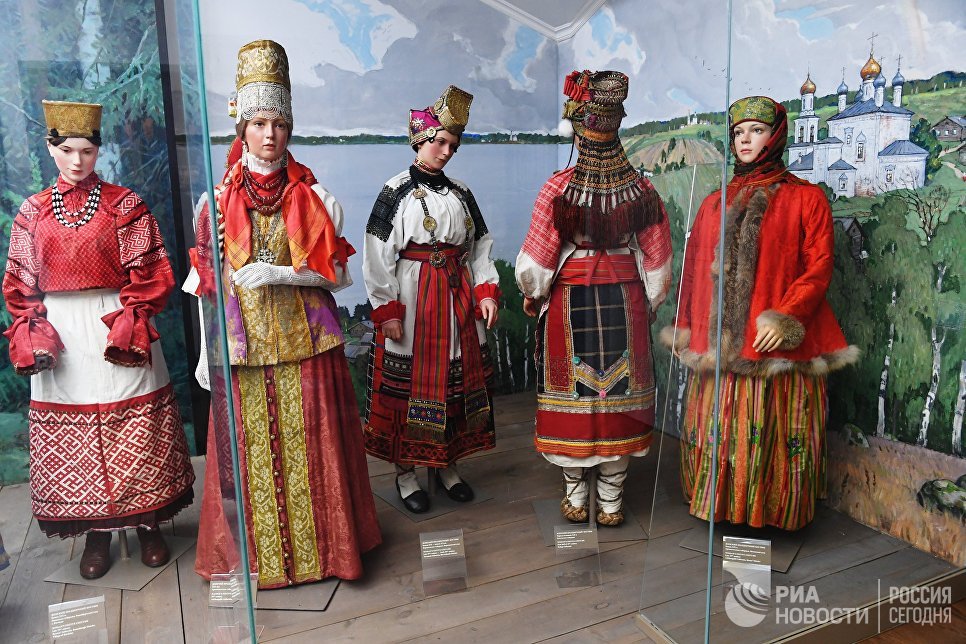
Next comes the traditional Kasuti embroidery with this characteristic cross-like design which is, in fact, a variation of the above fertility symbol:
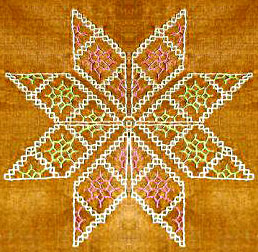
(http://birdsofoh.blogspot.co.uk/2011/01/kasuti-traditional-embroidery-from.html) See more wonderful Kasuti patterns here:
http://www.pinterest.com/isiscat/embroidery-indian-kasuti-patterns/
The same element is clearly seen in the centre and flower-like elements in this Russian embroidery:
Valance. The 19-th century. Olonetskaya province. Embroidered with a double running stitch in a combination of red cotton threads and coloured wool on flaxen cloth. 18 6 X 3 7 . Russian State Museum (Boguslavskaja 1975 fig. 22).
This pattern is also built around the ancient fertility theme: the two horses (each of them having their own life-force or seeds of life, represented by the flower-like design) are united to produce a new life (the flower design in the middle) which grows up in the form of the śrīvatsa श्रीवत्स / triratna त्रिरत्न . This design represents the fundamental idea: “division of the divine nature between a god and a goddess who, together with their child, form a natural trinity, glorifying and repeating on their divine plane the life of the human family” (Waites, M. C. “The Deities of the Sacred Axe”. American Journal of Archaeology, Archaeological Institute of America, 1923, 27, 25-56, p.34) . See more fertility related embroideries at pinterest.com.
This is only a brief comparison on a limited material but it fully confirms Žarnikova’s words and looking at this wonderful affinity I too could share the feeling of “the strong ties connecting us with our distant common ancestors through the millennia”.
This is a list of some most obvious Russian – Sanskrit cognate nouns. It is only a short-list in which I give only the generally accepted cognate pairs having the rating 5 & 6. Since one should compare similar forms, I give Russian nouns in a special transcription, approximated to Sanskrit Latin transliteration. Read the rest of this entry »
The topic of Iranian loans into Slavonic has become a common place in Slavistics reflecting, to a considerable extent, the stereotype view on Slavonic mainly as a target language for borrowing. In reality, the number of truly attested Iranian loans is confined to a rather short list of words. Strictly speaking, the term ‘iranism (иранизм)’, widely used in Russian linguistic literature, stands for a direct borrowing from one of the attested Iranian languages. However, according to the academician of the Russian Academy of Sciences Oleg Nikolajevič Trubačev, such loans are limited to a few cultural terms such as *kotъ ‘stall, small cattle shed’, *čьrtogъ ‘inner part of a house’, *gun’a ‘shabby clothes, rags’, *kordъ ‘short sward’, *toporъ ‘axe’ etc., plus a separately standing group of religious terms and names of gods. However, even if any of these words are indeed borrowings they may not necessarily be ‘iranisms’ in the true sense (i. e. direct borrowings from one of the attested Iranian languages). Read the rest of this entry »
This is a short list of some most obvious Russian – Sanskrit cognate verbs. Since one should compare similar forms, I give Russian verbs in the same format as Sanskrit verbs are presented in traditional dictionaries (for example in Monier Williams’ Sanskrit-English Dictionary): verbal root – 3rd person, singular, Present Tense form. For a comparison of conjugation paradigms see my other post. See also the Russian – Sanskrit nouns


